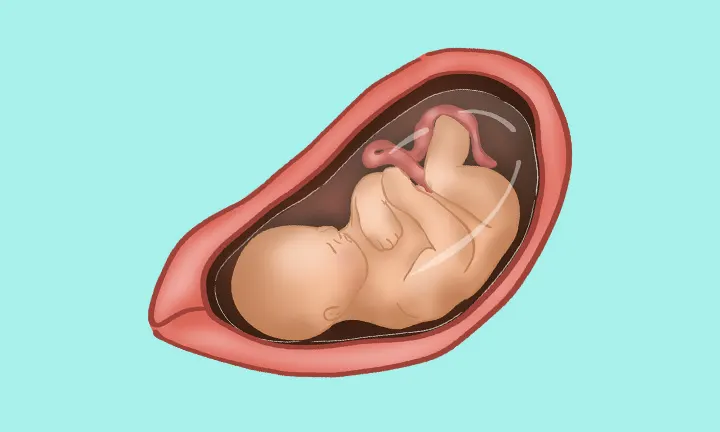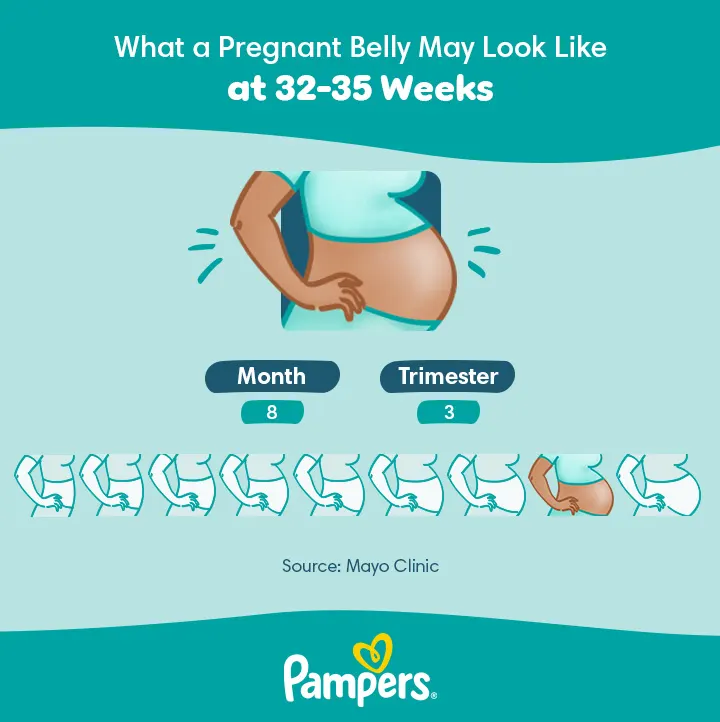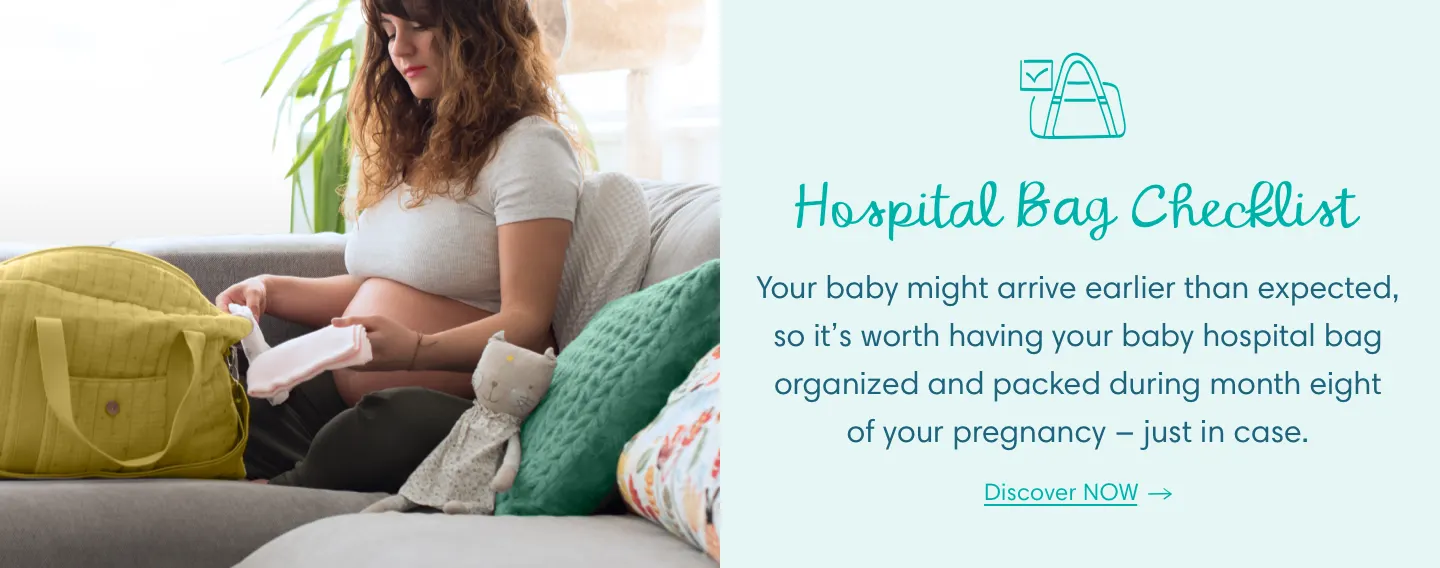33 Weeks Pregnant
Congratulations on reaching week 33 of your pregnancy! Each day brings you closer to the incredible moment of holding your little one in your arms. At 33 weeks pregnant, you may notice even more changes in your symptoms and the size of your baby bump – and we're here to support you throughout this journey! Let's explore what you might experience at 33 weeks pregnant, including some tips for sleeping better and easing pregnancy discomforts caused by your growing bump.
Highlights at 33 Weeks Pregnant
Before we get into all the details, here are some highlights and insights for 33 weeks pregnant:
Your little one is about the size of a small pineapple!
Their bones are hardening, but the skull is still soft – this helps facilitate childbirth.
Feeling tired? Make the most of your sleep by using some extra pillows to make yourself as comfortable as possible during the night – and take as many naps as you need!
At 33 weeks pregnant, you may be thinking about the right labour comfort measures for you.
Have you picked out any baby names for your little one yet? If not, take advantage of our Baby Name Generator:
BABY NAME GENERATOR TOOL

Baby name generator
By gender:
By theme:
Your Baby’s Development at 33 Weeks Pregnant
Here are some of your baby’s amazing developments at 33 weeks pregnant:
When you’re 33 weeks pregnant, your little one has a fully developed brain and nervous system and continues to grow. With about seven weeks to go until your due date, space is at a premium but there’s still room for movement inside your ever-expanding bump.
Around this week, your baby isn’t just gaining weight. Their bones are hardening up too. There’s one exception, though: The plates that make up the skull have a special trick. Unlike the other bones, they’ll remain soft and separated until after your baby is born.
This means the plates of your baby’s skull can give way a little under pressure and even slide over each other, easing your little one’s passage through the birth canal if you have a vaginal birth. This may sound alarming, but it’s perfectly normal.
As a result of the movement of the plates of the skull, your baby’s head might look a little squished or misshapen if you give birth vaginally. Don’t worry – this isn’t permanent and is quite common; your baby’s skull will regain its proper shape soon enough.
The plates of the skull won’t fuse together fully for a year or more after your baby is born. Until then, your baby will have a diamond-shaped soft spot on top of their head, known as the fontanelle. (There are actually two of these – one at the back, and one on top – but the one on the top is the most noticeable.)
Obviously you’ll want to take extra care to protect these sensitive spots until they close up, but until then they’ll be protected by a tough membrane, so you won’t need to worry about touching or washing them.
What Is 33 Weeks Pregnant in Months?
You know how far along you are in weeks, but how many months is 33 weeks pregnant? At this point, you’re likely in your eighth month, but there are a couple of different ways to group the weeks of pregnancy into months, so this can vary.
What Size Is a Baby at 33 Weeks Pregnant?
Now that you're 33 weeks pregnant, your baby is about the size of a pineapple, and there weight in kg is around 1.9 kilograms. Your baby may also measure close to 43.7 centimetres crown to rump.
Your Baby: What Does 33 Weeks Pregnant Look Like?
Look below at our illustration of what your baby might look like and what position they may be in at 33 weeks pregnant.
Your Body at 33 Weeks Pregnant
Nobody could blame you for feeling a little exhausted or under the weather at 33 weeks pregnant. With your increased size and protruding bump, you may be finding it harder to sleep through the night. Those frequent trips to the loo probably aren't helping much either.
Try to get more sleep by making your bed as comfortable as you can, adding plenty of extra pillows that you can use to support your belly and put between your legs for extra support.
Experts advise sleeping on your side when pregnant, as this is the safest sleeping position for your little one, especially at around 33 weeks pregnant and in the weeks that follow. Research suggests that sleeping on your back for long periods may affect the blood flow to your foetus.
Don't worry if you wake up and find you've rolled over onto your back, though. A certain amount of movement is natural. It's the position you're in when you drop off to sleep that matters – this is the pose you'll stay in for most of the time you're asleep.
Back pain is another of the pregnancy aches and pains that may be bothering you at 33 weeks pregnant.
Physical symptoms like pelvic and back pain can often be eased with gentle exercise. Ask your doctor what kinds of exercises are safe for you at around 33 weeks pregnant if you’re experiencing lower back pain and pelvic pressure.
If you're suffering from backache, you could look for a prenatal yoga class, or try this simple exercise:
Go down onto your hands and knees with a straight back, with your thighs pointing straight down and your hands positioned directly under your shoulders, with fingers facing forwards.
Raise your back by pulling in your stomach muscles, while letting your head drop gently downwards. Don't lock your elbows or raise your back more than is comfortable.
Stay like this for a few seconds, and then return to the starting position. Don't hollow your back, but just let it return to a natural, straight position.
Repeat this series of movements rhythmically and slowly about 10 times. Try and make your muscles work as hard as they can, without straining your back.
You can also help yourself to avoid back pain, or stop it from getting worse by avoiding heavy lifting and getting into good posture habits.
Good posture habits include bending at the knees and keeping a straight back if you need to pick something up, turning with your whole body instead of twisting your spine, and keeping your back straight and well-supported when seated.
If your mattress is too soft, especially now that you're probably a little heavier than you were when you bought it, this might be time to invest in a firmer one. Failing that, you could put a piece of board under your existing mattress to firm it up a bit.
Tell your midwife or doctor if you experience a sudden or unusual lower back pain or ache at 33 weeks or at any point in your pregnancy, especially if it's accompanied by other labour symptoms, such as regular or painful contractions or a trickle or flow of liquid from your vagina. These could be signs of premature labour.
Your Symptoms at 33 Weeks Pregnant
Here are some of the symptoms you may be experiencing at 33 weeks pregnant:
Frequent urination. Feeling the urge to pee more often is a common symptom that can strike at any time, no matter how many weeks or months pregnant you are. Your hormones deserve some of the blame for this, especially in the early stages, but at around 33 weeks pregnant it could also be caused by your baby putting extra pressure on your bladder. It's important to stay hydrated, so cutting down on your intake of water and non-alcoholic, non-caffeinated drinks isn't a good strategy for dealing with this symptom. Still, it's better not to have your last drink of the day just before you go to bed.
Braxton Hicks contractions. If you occasionally feel an unusual tightening in your belly around 33 weeks pregnant, it may be Braxton Hicks contraction. Your doctor or midwife will be able to double check this. Some people call Braxton Hicks ‘practice contractions', because they're your body's way of gearing up for the real thing. Each contraction last around 20-30 seconds and may be uncomfortable, but not painful. They might occur spontaneously, but can also be triggered by vigorous activity, sex during pregnancy or even just someone touching your bump. If you experience regular or painful contractions, period-like pains or cramping at around 33 weeks pregnant or later, let your midwife or doctor know immediately as this could be a sign and symptom of labour.
Swollen ankles. At 33 weeks pregnant, your growing uterus may be putting pressure on the veins that move blood around your legs. The resulting build-up of fluid can cause swelling in your feet, ankles and legs – a common complaint among pregnant people. Take the weight off your feet as much as possible to prevent or ease the swelling, and wear comfy shoes and socks that don't pinch or squeeze your feet. It might seem counter-intuitive, but drinking plenty of water actually helps reduce water retention, so be sure to stay hydrated. Normal swelling in pregnancy may be uncomfortable, but it won't usually harm you or your foetus. Some symptoms not to ignore at 33 weeks pregnant and onwards include sudden swelling in your face or extremities. If you experience this, call your doctor or midwife immediately, especially if you also have a severe headache, pain just below your ribs, or vision problems. These can be symptoms of pre-eclampsia, a rare but serious blood pressure condition that needs urgent treatment.
Carpal tunnel syndrome. If water retention is causing swelling in your hands and fingers at around 33 weeks pregnant, this can put pressure on the median nerve, which runs through your wrist, causing carpal tunnel syndrome. The symptoms include pain in the palm of your hand, thumbs and fingers, and sometimes muscle weakness, numbness or pins and needles. Carpal tunnel syndrome will usually go away by itself soon after your baby is born. Until then, you can try and ease the symptoms by cooling your hands with an ice pack. Wearing a wrist splint may help to keep your wrist straight while you're asleep. This can help reduce swelling by improving the circulation in your hand. If you've got carpal tunnel syndrome, ask your midwife or doctor about other ways of easing the symptoms.
Itchy skin. You may already have experienced itchiness due to hormonal changes during your pregnancy, but if you're feeling the urge to scratch the skin around your belly, breasts or thighs at around 33 weeks pregnant this could also be caused by your skin stretching as your bump (and body in general) continues to grow. If you experience severe or persistent itchy skin at around 33 weeks pregnant or any time in this stage of your pregnancy, especially if it's worse on the hands or feet, tell your midwife or doctor. This might be a symptom of a relatively uncommon but serious liver condition called intrahepatic cholestasis of pregnancy (ICP), which needs careful management. The itching associated with ICP if often worse at night, and could also be accompanied by other symptoms such as dark urine or pale stools.
What Size Is a Pregnant Belly at 33 Weeks?
Every pregnancy bump is different, so, your belly might not be the same size as someone else's at 33 weeks pregnant. However, it’s likely that your growing baby and expanding uterus are making your bump look fairly large right now.
As we mentioned throughout this article, there are many discomforts that may come with your expanding bump, and we provide some useful tips to help you feel more comfortable during this period.
What Does 33 Weeks Pregnant Look Like?
Take a peek at our visual below for a better idea of how your pregnancy bump may look around 33 weeks pregnant, in your eighth month.
Things to Consider at 33 Weeks Pregnant
From birthing positions to car seats, there are many things to consider and take care of during this period:
If you're planning to give birth vaginally, now might be a good time to investigate some birthing positions and techniques that could help make your labour a bit more comfortable. Do some research to find out more about the equipment and services that may be available to you at your local hospital or birthing centre. These can include anything from birthing chairs, stools, and balls, to birthing pools. Things like aromatherapy and massage might also be on offer. Ask your midwife what your hospital or birthing centre offers. Naturally, you won't know what feels best until you're actually in labour, but it doesn't hurt to explore your choices.
If you have older children think about who will mind them when you are in labour and who will take care of them during your hospital stay. Consider asking a family member to be on standby or to arrange a babysitter who can be available at short notice.
If you get around by car, you’ll need an approved car safety seat for when your baby arrives. Experts advise against buying second-hand car seats, because they may have been damaged or involved in an accident. Your newborn will need to travel in a rearward-facing seat. Now that you’re 33 weeks pregnant, it’s good idea to start researching essential baby gear like this. Choosing the right car seat can take a long time, as not all seats fit every car so you’ll probably need to try out various makes and models. A poorly fitting car seat will offer less protection for your baby. Another consideration when choosing a car safety seat is weight. If you think you’ll be lifting your baby’s car seat in an out of the car a lot, go for a lightweight model with a modular base that stays in the car. Practice installing the seat well in advance, so you won’t have any problems when it’s finally time to take your newborn baby home.
Have you packed your hospital bag? At 33 weeks pregnant, your due date is steadily approaching. Take a few minutes to read through our hospital bag checklist to make sure you've prepared everything you, your birth partner, and your baby will need while in the hospital.
Tip for Partners If you drive a car, have you purchased and installed your baby’s car seat? Now might be a good time to read about the necessary requirements and how to properly install a car seat for babies – you’ll be an expert in no time! You can find more information in the above section (Things to Consider). |
Questions for Your Doctor at 33 Weeks Pregnant
Your doctor or midwife are there to answer any questions you may have throughout your pregnancy. The following are some common questions that crop up at 33 weeks pregnant:
When will I get the Tdap vaccination?
If I think I might be in labour, how long should I wait before setting off for the hospital or birthing centre? Should I call the doctor or midwife, and what if it’s after hours?
Could diarrhoea be a symptom of premature labour at 33 weeks pregnant? Diarrhoea isn’t usually associated with pregnancy, and is more likely a stomach bug, especially if coupled with nausea or vomiting; however, if your diarrhoea is coupled with symptoms of labour, such as abdominal cramping and period-like pains at 33 weeks pregnant, you should contact your doctor or midwife.
Are there any tests or scans I need now or in the weeks ahead?
What kind of painkillers can I safely take for back or pelvic pain at 33 weeks pregnant?
What are the risks and benefits of an episiotomy, and in what circumstances would it be recommended?
What are some symptoms not to ignore at 33 weeks pregnant?
FAQS AT A GLANCE
Babies born at 33 weeks (or any time before 37 weeks) are considered premature and may require additional medical support in the neonatal care unit. Rest assured that medical professionals are here to provide the necessary care and support for both the baby and the parents during this crucial time.
33 Weeks Pregnant: Your Checklist
You can use our checklist to help guide you through week 33 of pregnancy:
☐ Map out the quickest route to the hospital or birthing centre, and do a few ‘practice runs’ so you have no trouble finding your way there when the time comes. If it’s a large hospital, don’t forget to locate the entrance or car park that’s closest to the maternity unit, and make sure you know exactly where to go once you’re inside the building.
☐ If you have a little spare time this week, sanitize your baby gear and wash your baby’s clothes, bedding and swaddle blankets.
☐ Organise your baby’s clothes by size. This makes it easier for you to find what you’re looking for no matter what size your baby is at birth and beyond.
☐ Get your baby’s nursery decorated and in order, and furnish it with some of these newborn baby essentials.
33 weeks pregnant - checklist
How We Wrote This Article The information in this article is based on the expert advice found in trusted medical and government sources, such as the National Health Service (NHS). You can find a full list of sources used for this article below. The content on this page should not replace professional medical advice. Always consult medical professionals for full diagnosis and treatment.




